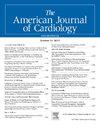左心发育不全综合征合并左室冠状动脉瘘患者中期预后分析。
IF 2.3
3区 医学
Q2 CARDIAC & CARDIOVASCULAR SYSTEMS
引用次数: 0
摘要
左心发育不良综合征(HLHS)合并二尖瓣狭窄/主动脉闭锁(MS/AA)的婴儿与其他解剖变异相比预后更差;这可能与左心室冠状动脉(LV-CA)瘘有关。我们回顾了从2008-2023年出生到波士顿儿童医院就诊的HLHS (MS/AA)患者,并比较了有和没有LV-CA瘘血管造影定义的患者。90例患者中,58例(64%)有左-左瘘。总共有66例(73%)患者接受了手术1期姑息(S1P), 22例(24%)患者接受了混合型S1P;混合型S1P在瘘管组中更为常见(36% vs 6%, p=0.002)。瘘患者1年无移植生存率为63% (95% CI 49%, 74%),无瘘患者为78% (95% CI 60%, 89%)。中位随访4.3年[IQR 0.5,7.9], 38例(42%)患者死亡或接受移植。在单因素分析中,较低的GA (HR 1.31, 95% CI 1.16, 1.48)、较低的体重(HR 1.68, 95% CI 1.28, 2.19)、初始混合S1P (HR 3.50, 95% CI 1.79, 6.84)和围手术期ECMO需求(HR 4.48, 95% CI 2.23, 8.99)与死亡/移植风险增加相关(P < 0.05)本文章由计算机程序翻译,如有差异,请以英文原文为准。
Mid-Term Outcomes of Patients With Hypoplastic Left Heart Syndrome and Left Ventricle-Coronary Artery Fistula
Infants with hypoplastic left heart syndrome (HLHS) with mitral stenosis/aortic atresia (MS/AA) have worse outcomes compared to other anatomic variants; this may be related to left ventricle-coronary artery (LV-CA) fistula. We reviewed patients with HLHS (MS/AA) referred to Boston Children's Hospital and managed from birth during 2008 to 2023 and compared those with and without LV-CA fistula defined angiographically. Among 90 patients, 58 (64%) had LV-CA fistula. In total, 66 (73%) of patients underwent surgical stage 1 palliation (S1P) and 22 (24%) underwent hybrid S1P; hybrid S1P was more common in the fistula group (36% vs 6%, p = 0.002). Probability of transplant-free survival at 1 year was 63% (95% CI 49%, 74%) for those with fistula and 78% (95% CI 60%, 89%) for those without. Over a median follow up of 4.3 years [IQR 0.5,7.9], 38 (42%) patients died or underwent transplant. In univariate analysis, lower GA (HR 1.31, 95% CI 1.16, 1.48), lower BW (HR 1.68, 95% CI 1.28, 2.19), initial hybrid S1P (HR 3.50, 95% CI 1.79, 6.84), and need for perioperative ECMO (HR 4.48, 95% CI 2.23, 8.99) were associated with increased risk of death/transplant (p <0.001 for all). The association of LV-CA fistula with death or transplant did not reach statistical significance (HR 1.83, 95% 0.89, 3.76, p = 0.10). Mortality remains high for children with HLHS (MS/AA) and while there was a trend toward worse transplant-free survival for children with LV-CA fistula compared to those without, factors other than LV-CA fistula may contribute.
求助全文
通过发布文献求助,成功后即可免费获取论文全文。
去求助
来源期刊

American Journal of Cardiology
医学-心血管系统
CiteScore
4.00
自引率
3.60%
发文量
698
审稿时长
33 days
期刊介绍:
Published 24 times a year, The American Journal of Cardiology® is an independent journal designed for cardiovascular disease specialists and internists with a subspecialty in cardiology throughout the world. AJC is an independent, scientific, peer-reviewed journal of original articles that focus on the practical, clinical approach to the diagnosis and treatment of cardiovascular disease. AJC has one of the fastest acceptance to publication times in Cardiology. Features report on systemic hypertension, methodology, drugs, pacing, arrhythmia, preventive cardiology, congestive heart failure, valvular heart disease, congenital heart disease, and cardiomyopathy. Also included are editorials, readers'' comments, and symposia.
 求助内容:
求助内容: 应助结果提醒方式:
应助结果提醒方式:


